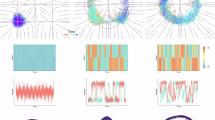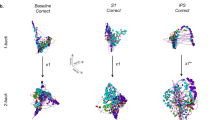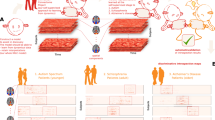Abstract
The complexity of the human brain gives the illusion that brain activity is intrinsically high-dimensional. Nonlinear dimensionality-reduction methods such as uniform manifold approximation and t-distributed stochastic neighbor embedding have been used for high-throughput biomedical data. However, they have not been used extensively for brain activity data such as those from functional magnetic resonance imaging (fMRI), primarily due to their inability to maintain dynamic structure. Here we introduce a nonlinear manifold learning method for time-series data—including those from fMRI—called temporal potential of heat-diffusion for affinity-based transition embedding (T-PHATE). In addition to recovering a low-dimensional intrinsic manifold geometry from time-series data, T-PHATE exploits the data’s autocorrelative structure to faithfully denoise and unveil dynamic trajectories. We empirically validate T-PHATE on three fMRI datasets, showing that it greatly improves data visualization, classification, and segmentation of the data relative to several other state-of-the-art dimensionality-reduction benchmarks. These improvements suggest many potential applications of T-PHATE to other high-dimensional datasets of temporally diffuse processes.
This is a preview of subscription content, access via your institution
Access options
Access Nature and 54 other Nature Portfolio journals
Get Nature+, our best-value online-access subscription
27,99 € / 30 days
cancel any time
Subscribe to this journal
Receive 12 digital issues and online access to articles
99,00 € per year
only 8,25 € per issue
Buy this article
- Purchase on SpringerLink
- Instant access to full article PDF
Prices may be subject to local taxes which are calculated during checkout






Similar content being viewed by others
Data availability
The Sherlock dataset was downloaded from the Dataspace Public Repository at the following link: http://arks.princeton.edu/ark:/88435/dsp01nz8062179. The StudyForrest dataset was accessed via DataLad68 from: https://github.com/psychoinformatics-de/studyforrest-data. Steps to reproduce our preprocessing pipeline and ROI extraction are available here: https://github.com/ericabusch/tphate_analysis_capsule (ref. 69). Source Data are provided with this paper.
Code availability
Data analysis code is written as custom Python scripts (v.3.6.13) based on sci-kit learn v.0.23.2 (https://scikit-learn.org/), nilearn v.0.9.2 (https://nilearn.github.io), nibabel v.4.0.1 (https://github.com/nipy/nibabel), PHATE v.1.0.7 (https://phate.readthedocs.io/en/stable/)28 and Brainiak v.0.11 (https://brainiak.org/)62. T-PHATE is available as a Python package at: https://github.com/KrishnaswamyLab/TPHATE (ref. 70). The pipeline to replicate all of the analyses presented here is available at: https://github.com/ericabusch/tphate_analysis_capsule (ref. 69).
References
Averbeck, B. B., Latham, P. E. & Pouget, A. Neural correlations, population coding and computation. Nat. Rev. Neurosci. 7, 358–366 (2006).
Laurent, G. Olfactory network dynamics and the coding of multidimensional signals. Nat. Rev. Neurosci. 3, 884–895 (2002).
Churchland, M. M., Cunningham, J. P., Kaufman, M. T., Ryu, S. I. & Shenoy, K. V. Cortical preparatory activity: representation of movement or first cog in a dynamical machine? Neuron 68, 387–400 (2010).
Chang, L. & Tsao, D. Y. The code for facial identity in the primate brain. Cell 169, 1013–1028.e14 (2017).
Freiwald, W. A. & Tsao, D. Y. Functional compartmentalization and viewpoint generalization within the macaque face-processing system. Science 330, 845 (2010).
Jazayeri, M. & Ostojic, S. Interpreting neural computations by examining intrinsic and embedding dimensionality of neural activity. Curr. Opinion Neurobiol. 70, 113–120 (2021).
Hennig, J. A. et al. Constraints on neural redundancy. eLife 7, e36774 (2018).
Nieh, E. H. et al. Geometry of abstract learned knowledge in the hippocampus. Nature 595, 80–84 (2021).
Cunningham, J. P. & Yu, B. M. Dimensionality reduction for large-scale neural recordings. Nat. Neurosci. 17, 1500–1509 (2014).
Norman, K. A., Polyn, S. M., Detre, G. J. & Haxby, J. V. Beyond mind-reading: multi-voxel pattern analysis of fmri data. Trends Cogn. Sci. 10, 424–430 (2006).
Cox, D. D. & Savoy, R. L. Functional magnetic resonance imaging (fMRI) ‘brain reading’: detecting and classifying distributed patterns of fMRI activity in human visual cortex. NeuroImage 19, 261–270 (2003).
Kamitani, Y. & Tong, F. Decoding the visual and subjective contents of the human brain. Nat. Neurosci. 8, 679–685 (2005).
Haxby, J. V. Distributed and overlapping representations of faces and objects in ventral temporal cortex. Science 293, 2425–2430 (2001).
Haynes, J.-D. & Rees, G. Decoding mental states from brain activity in humans. Nat. Rev. Neurosci. 7, 523–534 (2006).
Polyn, S. M., Natu, V. S., Cohen, J. D. & Norman, K. A. Category-specific cortical activity precedes retrieval during memory search. Science 310, 1963–1966 (2005).
Peelen, M. V., Atkinson, A. P. & Vuilleumier, P. Supramodal representations of perceived emotions in the human brain. J. Neurosci. 30, 10127–10134 (2010).
Yeshurun, Y., Nguyen, M. & Hasson, U. Amplification of local changes along the timescale processing hierarchy. Proc. Natl Acad. Sci. USA 114, 9475–9480 (2017).
Davatzikos, C. et al. Classifying spatial patterns of brain activity with machine learning methods: application to lie detection. NeuroImage 28, 663–668 (2005).
Birn, R. M., Smith, M. A., Jones, T. B. & Bandettini, P. A. The respiration response function: the temporal dynamics of fMRI signal fluctuations related to changes in respiration. NeuroImage 40, 644–654 (2008).
Turk-Browne, N. B. Functional interactions as big data in the human brain. Science 342, 580–584 (2013).
Gao, S., Mishne, G. & Scheinost, D. Nonlinear manifold learning in functional magnetic resonance imaging uncovers a low-dimensional space of brain dynamics. Hum. Brain Mapp. 42, 4510–4524 (2021).
Olszowy, W., Aston, J., Rua, C. & Williams, G. B. Accurate autocorrelation modeling substantially improves fMRI reliability. Nat. Commun. 10, 1220 (2019).
Golesorkhi, M. et al. The brain and its time: intrinsic neural timescales are key for input processing. Commun. Biol. 4, 1–16 (2021).
Ito, T., Hearne, L. J. & Cole, M. W. A cortical hierarchy of localized and distributed processes revealed via dissociation of task activations, connectivity changes, and intrinsic timescales. NeuroImage 221, 117141 (2020).
Shine, J. M. et al. The dynamics of functional brain networks: integrated network states during cognitive task performance. Neuron 92, 544–554 (2016).
Shine, J. M. et al. Human cognition involves the dynamic integration of neural activity and neuromodulatory systems. Nat. Neurosci. 22, 289–296 (2019).
Allen, E. A. et al. Tracking whole-brain connectivity dynamics in the resting state. Cerebral Cortex 24, 663–676 (2012).
Moon, K. R. et al. Visualizing structure and transitions in high-dimensional biological data. Nat. Biotechnol. 37, 1482–1492 (2019).
Tenenbaum, J. B., De Silva, V. & Langford, J. C. A global geometric framework for nonlinear dimensionality reduction. Science 290, 2319–2323 (2000).
Roweis, S. T. & Saul, L. K. Nonlinear dimensionality reduction by locally linear embedding. Science 290, 2323–2326 (2000).
Salhov, M., Bermanis, A., Wolf, G. & Averbuch, A. Approximately-isometric diffusion maps. Appl. Comput. Harmon. Anal. 38, 399–419 (2015).
Becht, E. et al. Dimensionality reduction for visualizing single-cell data using UMAP. Nature Biotechnol. 37, 38–44 (2019).
Gotts, S. J., Gilmore, A. W. & Martin, A. Brain networks, dimensionality, and global signal averaging in resting-state fMRI: hierarchical network structure results in low-dimensional spatiotemporal dynamics. NeuroImage 205, 116289 (2020).
Casanova, R. et al. Embedding functional brain networks in low dimensional spaces using manifold learning techniques. Front. Neuroinform. 15, 740143 (2021).
Mannfolk, P., Wirestam, R., Nilsson, M., Ståhlberg, F. & Olsrud, J. Dimensionality reduction of fMRI time series data using locally linear embedding. Magn. Res. Mater. Phy. 23, 327–338 (2010).
Van der Maaten, L. & Hinton, G. Visualizing data using t-SNE. J. Mach. Learn. Res. 9, 2579–2605 (2008).
Radvansky, G. A. & Zacks, J. M. Event boundaries in memory and cognition. Curr. Opin. Behav. Sci. 17, 133–140 (2017). Memory in time and space.
Zacks, J. M., Speer, N. K., Swallow, K. M. & Maley, C. J. The brain’s cutting-room floor: segmentation of narrative cinema. Front. Hum. Neurosci. 4, 168 (2010).
Zacks, J. M., Speer, N. K., Swallow, K. M., Braver, T. S. & Reynolds, J. R. Event perception: a mind-brain perspective. Psychol. Bull. 133, 273–293 (2007).
Zacks, J. M., Tversky, B. & Iyer, G. Perceiving, remembering, and communicating structure in events. J. Exp. Psychol. Gen. 130, 29–58 (2001).
Kurby, C. A. & Zacks, J. M. Segmentation in the perception and memory of events. Trends Cogn. Sci. 12, 72–79 (2008).
Baldassano, C. et al. Discovering event structure in continuous narrative perception and memory. Neuron 95, 709–721.e5 (2017).
Lee, C. S., Aly, M. & Baldassano, C. Anticipation of temporally structured events in the brain. eLife 10, e64972 (2021).
Baldassano, C., Hasson, U. & Norman, K. A. Representation of real-world event schemas during narrative perception. J. Neurosci. 38, 9689–9699 (2018).
MacDonald, I. L. & Zucchini, W. Hidden Markov and Other Models for Discrete-Valued Time Series Vol. 110 (CRC, 1997).
Yates, T. S. et al. Neural event segmentation of continuous experience in human infants. Proc. Natl Acad. Sci. USA 119, e2200257119 (2022).
Speer, N. K., Zacks, J. M. & Reynolds, J. R. Human brain activity time-locked to narrative event boundaries. Psychol.Sci. 18, 449–455 (2007).
DuBrow, S. & Davachi, L. The influence of context boundaries on memory for the sequential order of events. J. Exp. Psychol. Gen. 142, 1277–1286 (2013).
DuBrow, S. & Davachi, L. Temporal binding within and across events. Neurobiol. Learn. Mem. 134, 107–114 (2016).
Ezzyat, Y. & Davachi, L. Similarity breeds proximity: pattern similarity within and across contexts is related to later mnemonic judgments of temporal proximity. Neuron 81, 1179–1189 (2014).
Chen, J. et al. Shared memories reveal shared structure in neural activity across individuals. Nat. Neurosci. 20, 115–125 (2017).
Hasson, U., Yang, E., Vallines, I., Heeger, D. J. & Rubin, N. A hierarchy of temporal receptive windows in human cortex. J. Neurosci. 28, 2539–2550 (2008).
Zacks, J. M. et al. Human brain activity time-locked to perceptual event boundaries. Nat. Neurosci. 4, 651–655 (2001).
Haxby, J. V., Connolly, A. C. & Guntupalli, J. S. Decoding neural representational spaces using multivariate pattern analysis. Ann. Rev. Neurosci. 37, 435–456 (2014). PMID: 25002277.
Rodosthenous, T., Shahrezaei, V. & Evangelou, M. S-multi-SNE: semi-supervised classification and visualisation of multi-view data. Preprint at https://arxiv.org/abs/2111.03519 (2021).
Rodosthenous, T., Shahrezaei, V. & Evangelou, M. Multi-view data visualisation via manifold learning. Preprint at https://arxiv.org/abs/2101.06763 (2021).
Kuchroo, M. et al. Multiscale phate identifies multimodal signatures of covid-19. Nat. Biotechnol. 40, 681–691 (2022).
Moon, K. R. et al. Manifold learning-based methods for analyzing single-cell RNA-sequencing data. Curr. Opin. Syst. Biol. 7, 36–46 (2018).
Himberger, K. D., Chien, H.-Y. & Honey, C. J. Principles of temporal processing across the cortical hierarchy. Neuroscience 389, 161–174 (2018). Sensory Sequence Processing in the Brain.
Brockwell, P. J. & Davis, R. A. Introduction to Time Series and Forecasting (Springer, 2002).
Shin, Y. S. & DuBrow, S. Structuring memory through inference-based event segmentation. Topics Cogn. Sci. 13, 106–127 (2021).
Kumar, M. et al. Brainiak: The Brain Imaging Analysis Kit (BrainIAK, 2020).
Vodrahalli, K. et al. Mapping between fMRI responses to movies and their natural language annotations. NeuroImage 180, 223–231 (2018).
Hanke, M. et al. A studyforrest extension, simultaneous fMRI and eye gaze recordings during prolonged natural stimulation. Sci. Data 3, 160092 (2016)..
Sengupta, A. et al. A studyforrest extension, retinotopic mapping and localization of higher visual areas. Sci. Data 3, 160093 (2016).
Haxby, J. V., Guntupalli, J. S., Nastase, S. A. & Feilong, M. Hyperalignment: modeling shared information encoded in idiosyncratic cortical topographies. eLife 9, e56601 (2021).
Shirer, W. R., Ryali, S., Rykhlevskaia, E., Menon, V. & Greicius, M. D. Decoding subject-driven cognitive states with whole-brain connectivity patterns. Cereb Cortex 22, 158–165 (2012).
Halchenko, Y. O. et al. Datalad: distributed system for joint management of code, data, and their relationship. J. Open Source Softw. 6, 3262 (2021).
Busch, E. ericabusch/tphate_analysis_capsule Version 2 release (Zenoodo, 2023); https://doi.org/10.5281/zenodo.7626543
Busch, E. Krishnaswamylab/tphate Initial release (Zenodo, 2023); https://doi.org/10.5281/zenodo.7637523
Acknowledgements
We thank Ariadne Letrou for reviewing the code and the helpful discussions. E.L.B. was supported by a NSF Graduate Research Fellowship (award no. 2139841). G.L. was supported by Canada CIFAR AI Chair and Canada Research Chair in Neural Computations and Interfacing. G.W. was supported by Canada CIFAR AI Chair and IVADO Professor research funds. S.K. was supported by the NIH (grant nos. R01GM135929 and R01GM130847), an NSF Career Grant (grant no. 2047856) and a Sloan Fellowship (grant no. FG-2021-15883). N.B.T-B. was supported by an NSF Grant CCF (grant no. 1839308) and CIFAR.
Author information
Authors and Affiliations
Contributions
E.L.B., J.H., G.W., G.L., S.K. and N.B.T-B. conceived the idea. E.L.B., J.H., A.B. and S.K. designed the T-PHATE algorithm. E.L.B., J.H. and T.W. developed the T-PHATE software. E.L.B. curated the data, and designed and performed analyses. E.L.B., S.K. and N.B.T-B. wrote the initial paper draft. All authors revised the paper. S.K. and N.B.T-B. jointly supervised the work.
Corresponding author
Ethics declarations
Competing interests
S.K. is a visiting professor at META Fundamental AI Research (FAIR). The other authors declare no competing interests.
Peer review
Peer review information
Nature Computational Science thanks the anonymous reviewers for their contribution to the peer review of this work. Handling editor: Ananya Rastogi, in collaboration with the Nature Computational Science team.
Additional information
Publisher’s note Springer Nature remains neutral with regard to jurisdictional claims in published maps and institutional affiliations.
Supplementary information
Supplementary Information
Supplementary methods, additional analysis and Figs. 1–9.
Supplementary Data 1
Source Data for supplementary figures.
Source data
Source Data Fig. 1
Data to generate Fig. 1c.
Source Data Fig. 2
Data to generate Fig. 2b.
Source Data Fig. 3
Data to generate Fig. 3c.
Source Data Fig. 5
Data to generate Fig. 5a,b.
Source Data Fig. 6
Data to generate Fig. 6a,c.
Rights and permissions
Springer Nature or its licensor (e.g. a society or other partner) holds exclusive rights to this article under a publishing agreement with the author(s) or other rightsholder(s); author self-archiving of the accepted manuscript version of this article is solely governed by the terms of such publishing agreement and applicable law.
About this article
Cite this article
Busch, E.L., Huang, J., Benz, A. et al. Multi-view manifold learning of human brain-state trajectories. Nat Comput Sci 3, 240–253 (2023). https://doi.org/10.1038/s43588-023-00419-0
Received:
Accepted:
Published:
Issue Date:
DOI: https://doi.org/10.1038/s43588-023-00419-0
This article is cited by
-
Centering cognitive neuroscience on task demands and generalization
Nature Neuroscience (2024)
-
The human claustrum tracks slow waves during sleep
Nature Communications (2024)
-
Predicting multiple observations in complex systems through low-dimensional embeddings
Nature Communications (2024)



